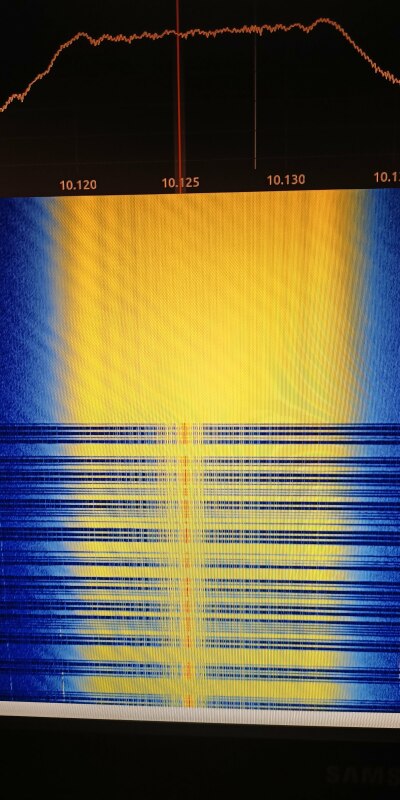Sunday, December 18. 2022
Memorable QSOs

He who does radio communication has stories to tell: During the time as an active a ham, memorable stories are accumulating. I want to document these for me before I forget the details. I’m licensed since four years now, and during the last three years I was using CW almost exclusively on the air. In this short time I was collecting (only) a few special moments which I want to share here.
Under the radar
The count and variety of HF band intruders has risen since the Russian invasion in Ukraine this year. One really annoying case are over-the-horizon radars sending in ham radio bands, as these transmissions always consume a remarkable frequency range. These radars can be recognized clearly due to their buzzing sound and tremendous signal strength, so it is pointless to attempt anything over these blockades. (Some hams however try to deliberately disturb these transmissions, but that’s comparable to a bird yelling at a bulldozer.) This April I was in the middle of a QSO with a Briton on the 30 m band, when suddenly a radar burst in, with us being exactly surrounded by noise. It kicked in during my transmission. I was puzzled when I heard it (I use full break-in to receive between my characters), but I had no choice other than continuing my message. It would be hopeless, I thought, to catch any response from my fellow. But, alas, his CW beeps could be clearly distinguished from the buzzing radar noise! I quickly launched Audacity and recorded the rest of our QSO. Try to hear for yourself: (Warning: Noisy!)
(I tried to enhance the audio later by filtering around 700 Hz, but every attempt made it worse. CW can be distinguished best from the full radar spectrum, interestingly.) I also made a picture of my SDR receiver’s waterfall diagram after one of my transmissions. You cannot make out my friend’s signal visually, though:
So, despite this heavy QRM, we could continue and finalize our conversation, thanks to the powers of morse telegraphy. ![]()
QSL via e-mail
I really enjoy exchanging paper QSL cards, especially receiving them from DXpeditions or DX stations. I decorate my shack’s wall with the most picturesque of them. While it makes past QSOs special by having them materialized in paper form, these processes are mostly automated: The prints are generated out of the log program and a common greeting is added. One kind of extra mile and appreciation of a recent contact, however, is an almost immediate personal e-mail after the QSO. For example, I answered two Brits which appeared to be beginners and to have one of their first HF sessions in each other’s company. I had a nice QRS QSO with each of them, and both of them thanked me kindly via e-mail soon after. I also received an e-mail from a young Indonesian after our QSO on 10 m this April.
One very thankful e-mail was again from England. Usually, the weaker signals are most interesting: Is it from far away? Is the station using low power and might thus not get plenty of answers? Will they be able to hear me at all? Well, it turned out, he was QRPP, sending with only 1 W, but easily bridged the 1200 km between us. He later sent me a picture of his setup on the kitchen table, where his TRX was powered by a 9 V battery. I was almost embarassed by me blowing out 100 W. It might have been interesting if I could have turned my output down to 5 W and still have this QSO.
Easy DX
We are three years into the current solar cycle with DX conditions having clearly improved this year’s summer term. Previously, I operated from a garage where I could use my hex beam in a portable-like setup. Since the pandemic I mostly operate from home, using home-made full-size wire loops for 20 m and 30 m and a home-made end-fed for the lower bands. These aren’t directional antennas, though, but I can use them more often, and they are good enough—good enough to have remarkable DX stations reply to my CQ calls: This May I did an unexpectant CQ call on 20 m, and then someone replied with a crystal clear signal... from Indonesia! We had a very nice QSO with hardly any fading. Sadly, I don’t have a recording. I should systematically record my sessions from now on.
Return at first attempt
This is actually just a side note what difference a directional antenna makes compared to a long wire. What positively surprised me during my first hours with my hex beam continued to be awesome whenever I used it: Often, when I joined the pile-up for a DXpedition or DX station with my 100 W rig, only one or a few calls were necessary on my side to already hear the DX station repeat my call! This was already the case when I did SSB. But also my wire loops enabled me to experience these first-attempt successes, since the solar condx are improving.
Getting licensed close to a solar minimum has the advantage of positive surprises for years to come. ![]()
About
Calendar
| Mon | Tue | Wed | Thu | Fri | Sat | Sun |
|---|---|---|---|---|---|---|
| ← Back | December '25 | Forward → | ||||
| 1 | 2 | 3 | 4 | 5 | 6 | 7 |
| 8 | 9 | 10 | 11 | 12 | 13 | 14 |
| 15 | 16 | 17 | 18 | 19 | 20 | 21 |
| 22 | 23 | 24 | 25 | 26 | 27 | 28 |
| 29 | 30 | 31 | ||||
